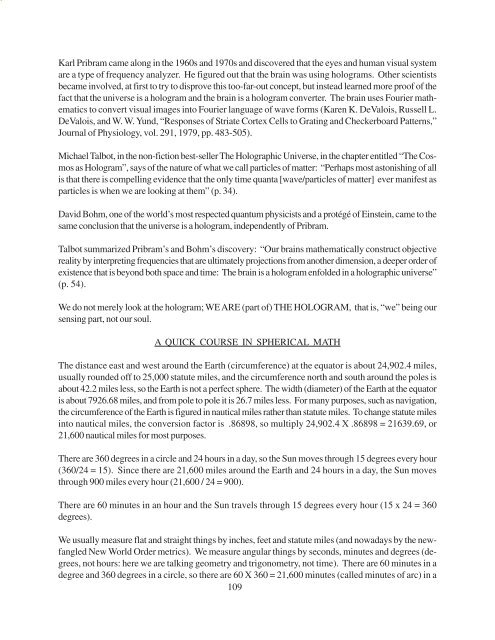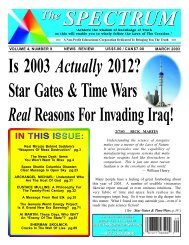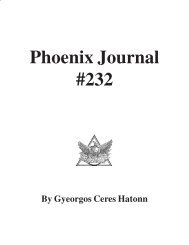Phoenix Journal 208 - Four Winds 10
Phoenix Journal 208 - Four Winds 10
Phoenix Journal 208 - Four Winds 10
Create successful ePaper yourself
Turn your PDF publications into a flip-book with our unique Google optimized e-Paper software.
Karl Pribram came along in the 1960s and 1970s and discovered that the eyes and human visual system<br />
are a type of frequency analyzer. He figured out that the brain was using holograms. Other scientists<br />
became involved, at first to try to disprove this too-far-out concept, but instead learned more proof of the<br />
fact that the universe is a hologram and the brain is a hologram converter. The brain uses <strong>Four</strong>ier mathematics<br />
to convert visual images into <strong>Four</strong>ier language of wave forms (Karen K. DeValois, Russell L.<br />
DeValois, and W. W. Yund, “Responses of Striate Cortex Cells to Grating and Checkerboard Patterns,”<br />
<strong>Journal</strong> of Physiology, vol. 291, 1979, pp. 483-505).<br />
Michael Talbot, in the non-fiction best-seller The Holographic Universe, in the chapter entitled “The Cosmos<br />
as Hologram”, says of the nature of what we call particles of matter: “Perhaps most astonishing of all<br />
is that there is compelling evidence that the only time quanta [wave/particles of matter] ever manifest as<br />
particles is when we are looking at them” (p. 34).<br />
David Bohm, one of the world’s most respected quantum physicists and a protégé of Einstein, came to the<br />
same conclusion that the universe is a hologram, independently of Pribram.<br />
Talbot summarized Pribram’s and Bohm’s discovery: “Our brains mathematically construct objective<br />
reality by interpreting frequencies that are ultimately projections from another dimension, a deeper order of<br />
existence that is beyond both space and time: The brain is a hologram enfolded in a holographic universe”<br />
(p. 54).<br />
We do not merely look at the hologram; WE ARE (part of) THE HOLOGRAM, that is, “we” being our<br />
sensing part, not our soul.<br />
A QUICK COURSE IN SPHERICAL MATH<br />
The distance east and west around the Earth (circumference) at the equator is about 24,902.4 miles,<br />
usually rounded off to 25,000 statute miles, and the circumference north and south around the poles is<br />
about 42.2 miles less, so the Earth is not a perfect sphere. The width (diameter) of the Earth at the equator<br />
is about 7926.68 miles, and from pole to pole it is 26.7 miles less. For many purposes, such as navigation,<br />
the circumference of the Earth is figured in nautical miles rather than statute miles. To change statute miles<br />
into nautical miles, the conversion factor is .86898, so multiply 24,902.4 X .86898 = 21639.69, or<br />
21,600 nautical miles for most purposes.<br />
There are 360 degrees in a circle and 24 hours in a day, so the Sun moves through 15 degrees every hour<br />
(360/24 = 15). Since there are 21,600 miles around the Earth and 24 hours in a day, the Sun moves<br />
through 900 miles every hour (21,600 / 24 = 900).<br />
There are 60 minutes in an hour and the Sun travels through 15 degrees every hour (15 x 24 = 360<br />
degrees).<br />
We usually measure flat and straight things by inches, feet and statute miles (and nowadays by the newfangled<br />
New World Order metrics). We measure angular things by seconds, minutes and degrees (degrees,<br />
not hours: here we are talking geometry and trigonometry, not time). There are 60 minutes in a<br />
degree and 360 degrees in a circle, so there are 60 X 360 = 21,600 minutes (called minutes of arc) in a<br />
<strong>10</strong>9
















